北师大版七年级下册英语教案《Lesson7Shopping for Food》
- 格式:doc
- 大小:49.01 KB
- 文档页数:7
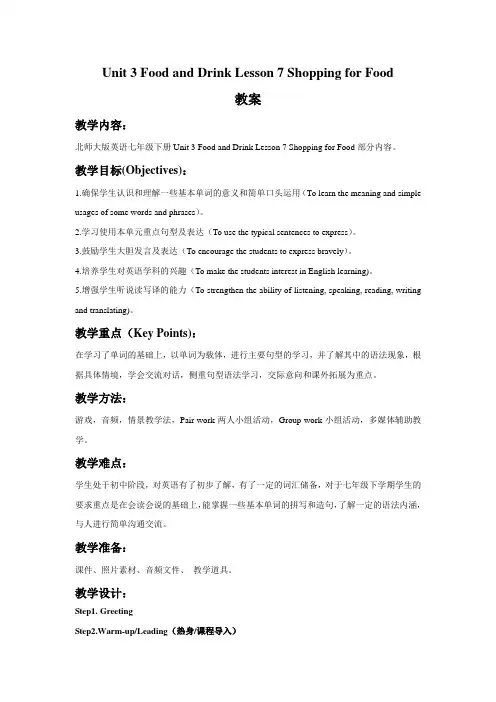
Unit 3 Food and Drink Lesson 7 Shopping for Food教案教学内容:北师大版英语七年级下册Unit 3 Food and Drink Lesson 7 Shopping for Food部分内容。
教学目标(Objectives):1.确保学生认识和理解一些基本单词的意义和简单口头运用(To learn the meaning and simple usages of some words and phrases)。
2.学习使用本单元重点句型及表达(To use the typical sentences to express)。
3.鼓励学生大胆发言及表达(To encourage the students to express bravely)。
4.培养学生对英语学科的兴趣(To make the students interest in English learning)。
5.增强学生听说读写译的能力(To strengthen the ability of listening, speaking, reading, writing and translating)。
教学重点(Key Points):在学习了单词的基础上,以单词为载体,进行主要句型的学习,并了解其中的语法现象,根据具体情境,学会交流对话,侧重句型语法学习,交际意向和课外拓展为重点。
教学方法:游戏,音频,情景教学法,Pair-work两人小组活动,Group-work小组活动,多媒体辅助教学。
教学难点:学生处于初中阶段,对英语有了初步了解,有了一定的词汇储备,对于七年级下学期学生的要求重点是在会读会说的基础上,能掌握一些基本单词的拼写和造句,了解一定的语法内涵,与人进行简单沟通交流。
教学准备:课件、照片素材、音频文件、教学道具。
教学设计:Step1. GreetingStep2.Warm-up/Leading(热身/课程导入)Warm-up Question 1How do you say the prices? Listen and fill in the blanks.Key words: prices/weightsPrice: cent, dollar, pound, yuanWeights: kilo(kg), pound(lb)Warm-up Question 2Discussion: Do you often go shopping with your Mum?What do you usually buy?Can you share us some experiences?...Step3.Presentation(呈现新课)1.Words Learning!1)老师放映课件,用中文询问同学看到了什么?同学们会看到课件上呈现的图画。
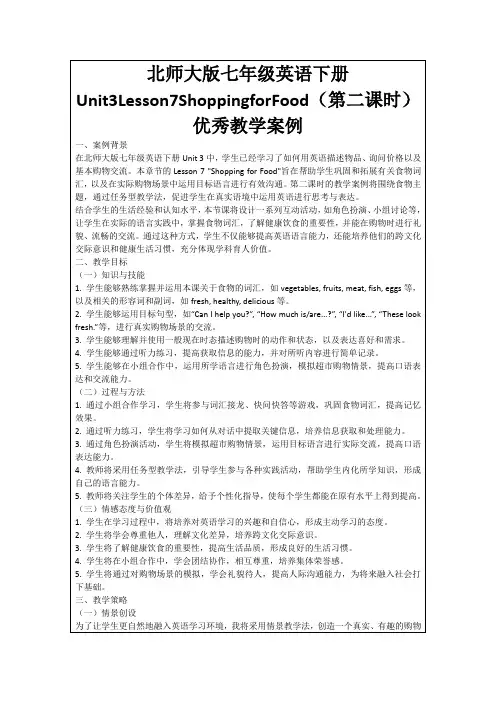
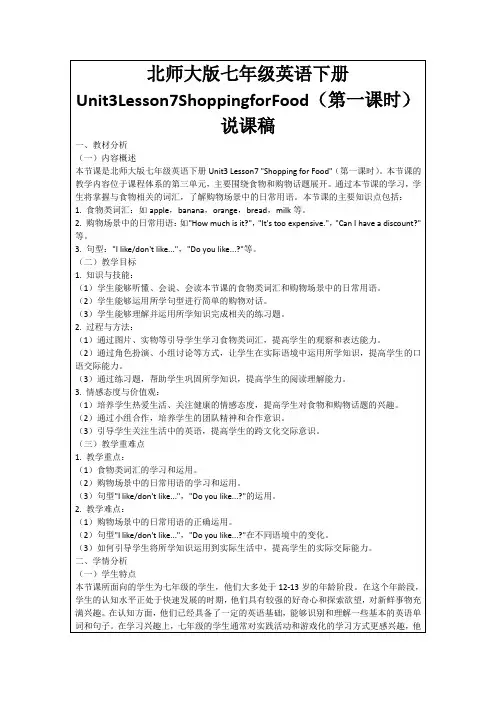
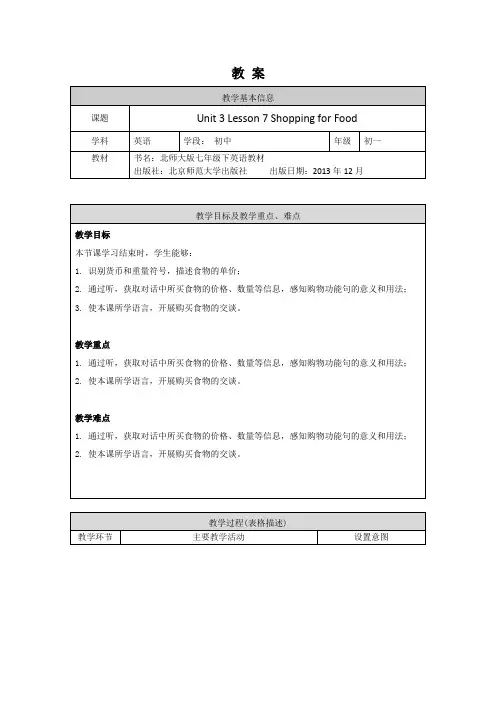
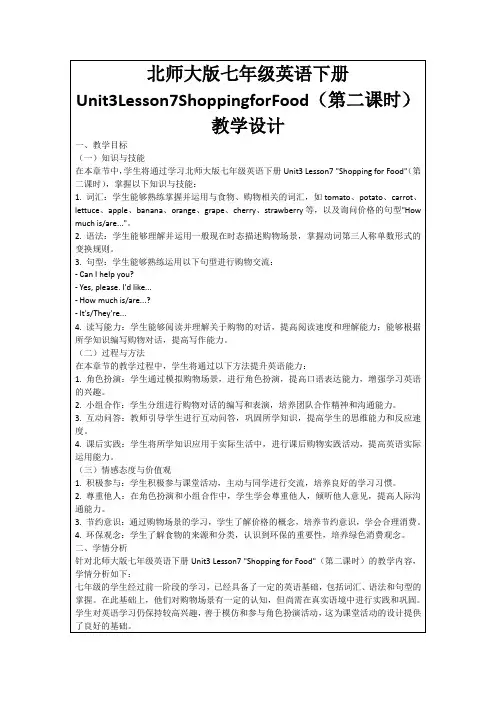
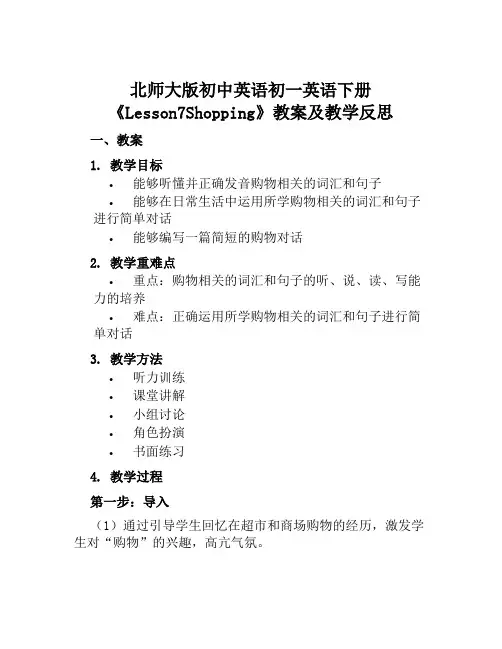
北师大版初中英语初一英语下册《Lesson7Shopping》教案及教学反思一、教案1. 教学目标•能够听懂并正确发音购物相关的词汇和句子•能够在日常生活中运用所学购物相关的词汇和句子进行简单对话•能够编写一篇简短的购物对话2. 教学重难点•重点:购物相关的词汇和句子的听、说、读、写能力的培养•难点:正确运用所学购物相关的词汇和句子进行简单对话3. 教学方法•听力训练•课堂讲解•小组讨论•角色扮演•书面练习4. 教学过程第一步:导入(1)通过引导学生回忆在超市和商场购物的经历,激发学生对“购物”的兴趣,高亢气氛。
(2)通过 PPT 展示图片或小视频,“购物”的现场、步骤演示。
第二步:呈现通过 PPT 展示单词及图片,呈现“购物”相关单词及图片。
另外,教师可以制作购物清单,带进课堂,通过集体讨论,巩固所学词汇。
第三步:实践(1)小组讨论将学生分组(每组不超过 5 个人),让他们彼此之间用已学的单词和句子进行谈话,交流自己的购物经历,讨论个人认为的优惠购物技巧,提高学生的听、说能力,激发学生的学习兴趣。
(2)角色扮演通过角色扮演,让学生在情境中模拟购物对话,演练所学购物的词汇和句子,加强学生口语表达能力。
(3)书面练习通过家庭作业或小测验,让学生运用所学单词和句子编写一篇关于“购物”的简短对话,检验学生对于所学知识的掌握情况。
第四步:总结和评价通过教师点评和同学间讨论,总结所学购物相关单词、句子、技巧,展示高质量学生的“购物”作品,对学生的购物能力进行评价激发学生的自信心。
5. 教学评价•通过小组讨论、角色扮演等活动,学生在交流中自然而然地运用所学词汇和句子,提高了学生的口语表达能力。
•通过家庭作业或小测验,检验学生对于所学知识的掌握情况。
•通过教师点评和同学间讨论,促进学生对所学内容的深入思考和理解。
二、教学反思本节课主要采用听说读写相结合的教学方法,帮助学生快速提高购物相关的词汇和句子的听、说、读、写能力。
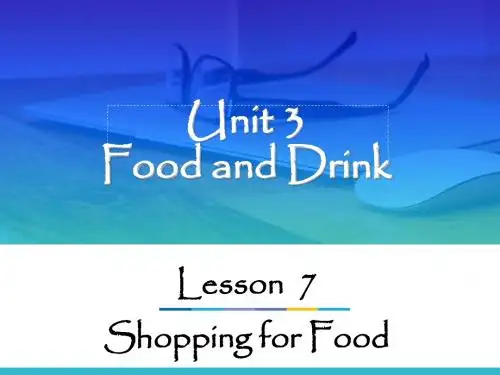
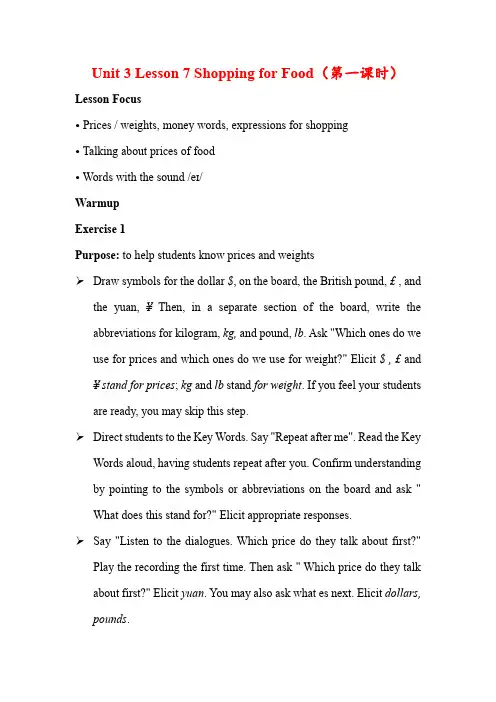
Unit 3 Lesson 7 Shopping for Food(第一课时)Lesson Focus• Prices / weights, money words, expressions for shopping• Talking about prices of food• Words with the sound /eɪ/WarmupExercise 1Purpose: to help students know prices and weights➢Draw symbols for the dollar $, on the board, the British pound, £ , and the yuan, ¥Then, in a separate section of the board, write the abbreviations for kilogram, kg, and pound, lb. Ask "Which ones do we use for prices and which ones do we use for weight?" Elicit $ , £ and ¥ stand for prices; kg and lb stand for weight. If you feel your students are ready, you may skip this step.➢Direct students to the Key Words. Say "Repeat after me". Read the Key Words aloud, having students repeat after you. Confirm understanding by pointing to the symbols or abbreviations on the board and ask "What does this stand for?" Elicit appropriate responses.➢Say "Listen to the dialogues. Which price do they talk about first?"Play the recording the first time. Then ask " Which price do they talk about first?" Elicit yuan. You may also ask what es next. Elicit dollars, pounds.➢Ask "How do you say the prices? Listen and fill in the blanks". Play the recording again, pausing if necessary after each dialogue. Monitor as students write the prices, offering assistance as needed.➢Go over the answers, asking individual students to say the prices aloud.Give students lots of practice saying prices. Write more prices on the board and ask students to say them, first as a class, then have half the class say a price, then the other half say one, then have each row say one, and finally have individual students say prices.Answersyuan, dollars, poundExpansion: Expansion: Mix It Up!As an alternate approach to teaching the Key Words, prepare cards with the symbols and abbreviations written on them, as well as the words. Have students work in pairs to match the words with their symbols or abbreviations. Then have the pairs walk around the room to check other students' work. Give them a minute to go back to their station and correct any mistakes if necessary.ListeningExercise 2Purpose: to help students listen to dialogues and match them with pictures ➢Direct students to the photos. Indicate the photos of landmarks in ovals in the righthand corners. Ask "Where are they?" Elicit picture a, China;picture b, England; picture c, the United States.If you feel your students are ready to do the exercise, you may skip this step.➢Say " Now listen to the dialogues again. Match them with the pictures".Monitor as students listen, offering assistance as needed. If students need support, you may have them work in pairs.• Go over the answers, asking individual students to say the answers aloud. Encourage students to answer in plete sentences, for example, The first dialogue is picture a.Answers1: a; 2: c: 3: bExercise 3Purpose: to help students plete shopping receipts➢Direct students to the receipts, or bring in some real ones from home.Ask " Do you know what these are?" Elicit or provide receipts. Explain that a salesperson gives you areceipt after you've bought something.Direct them to the first lines of each receipt ( vegetable, meat, fruit ).Then ask " Which receipt goes with which picture?" Elicit or provide South Market is picture a; The Meat Shop is picture c; Fresh Fruit Shop is picture b. If you feel your students are ready to do the exercise, you may skip this step.➢Ask " What information is usually on a receipt?" Elicit The things you bought, the price, the amount, and the total. Teach the information on the receipts. Explain that unit price is the price of the food per weight.Point out that the symbol / means per, as in 5 per kilo, but we usually just say 5 a kilo.Explain that the total is the price of all the food together. Explain that a bill (or note for British pounds) is one piece ofmoney, usually made of paper or cloth. Show students some yuan bills, or if you have some pound notes or dollar bills, show them those.Explain that in the dialogues, the shoppers each give a bill to the salesperson to pay for their food. Explain that change is the amount of money you get back from the salesperson when you pay for your food.Also, before listening, make sure students understand the phrase a half.Revise how to write prices with the currency symbol first and a decimal point to show the cents / pence.➢Have students get into pairs. Say "Listen again and plete the first receipt". Play the recording again, pausing after the first dialogue. Give students a few moments to plete the receipts. Monitor, offering assistance as needed. You may wish to go over the answers to make sure students are on the right track. Then play the second dialogue, having students plete the receipt. Continue with the same procedure with the last dialogue.➢Go over the answers, having individual students write them on the board as they say the answers aloud. Check students' pronunciation of the Key Words.AnswersSouth Market: tomatoes, 7. 60, 8. 74, 50,The Meat Shop: beef, 2.99, 8.97, 20, 11. 03Fresh Fruit Shop: apples, 1.20, two and a half, 3Exercise 4.Purpose: to help students answer questions based on receipts➢Have students get into pairs. Direct students to the receipts in Exercise3. Say "Study the receipts. Answer the questions". Monitor as studentsanswer the questions, offering help as needed.➢Go over the answers, having individual students say them aloud. Check students' pronunciation of the Key Words.Answers1. Y41.26;2. $ 2.99 a pound, $ 8.97;Expansion: Don't Stop!Note; Use this activity to give students more practice. Bring in either pictures of the food or play food that your students have learned. Have three groups, and assign each group a different currency. Each group has to decide how much the food costs, per pound or kilo. Have them set up their own shop with the food displayed and priced. They may even write out receipts, similar to those in Exercise 3.VocabularyExercise 5Purpose: to help students plete sentences with expressions for shopping ➢Direct students to the receipts in Exercise 3. Revise the information.Ask students questions to confirm prehension of the information of the receipts, for example, "What's the unit price for the tomatoes on thefirst receipt?" If you feel your students are ready to do the exercise, you may skip this step.➢Direct students to the sentences. Say "plete the sentences with the words in the box". Monitor as students plete the sentences, offering assistance as needed. If students need support, have them work in pairs.➢Go over the answers, asking individual students say the sentences aloud.Answers1. unit price, total;2. dollar, bill, change;3. money➢If time allows, do Workbook page 88, Exercise 2. Alternately, assign for homework.FunctionExercise 6Purpose: to help students know expressions for shopping➢Play the first line of the first dialogue of the recording from Exercise 2.Write How much are the tomatoes? on the board. Ask " What's the question word here?" Elicit or provide how much. Explain that when you want to know the price of something, you ask How much? Play the second line. Write How many do you want? on the board. Explain that when a salesperson wants to know what you want to buy, he or she will ask How many? to learn the number, or how much? to learn the weight.➢Direct students to the Key Expressions. Read them aloud, havingstudents repeat after you. Practise the Key Expressions by randomly saying a question or the statement on the left and eliciting the correct responses from the students. Have students volunteer to say the questions or statement and other students respond. You may also have them work in pairs to practise.Expansion: Mir It Up!As an alternate approach to teaching the Key Expressions, or as a review, print out the Key Expressions on a piece of paper, one for each pair of students. Cut the paper so that the questions and the statement, on the left, and the responses, on the right, are on separate strips. Have students work in pairs to match the questions and statement with the correct responses.。

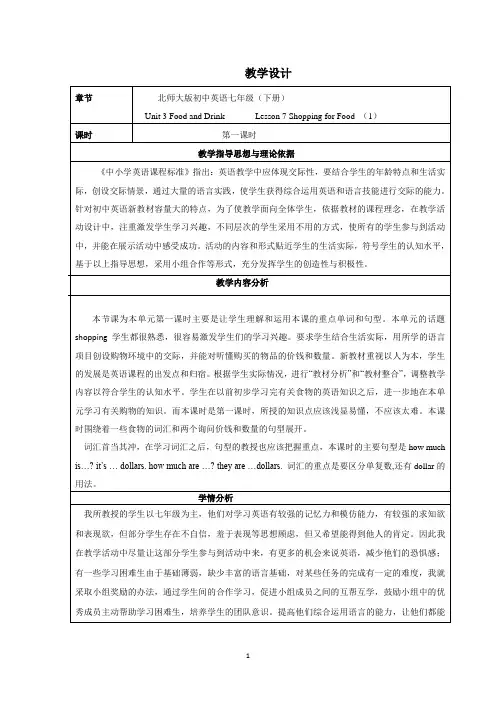
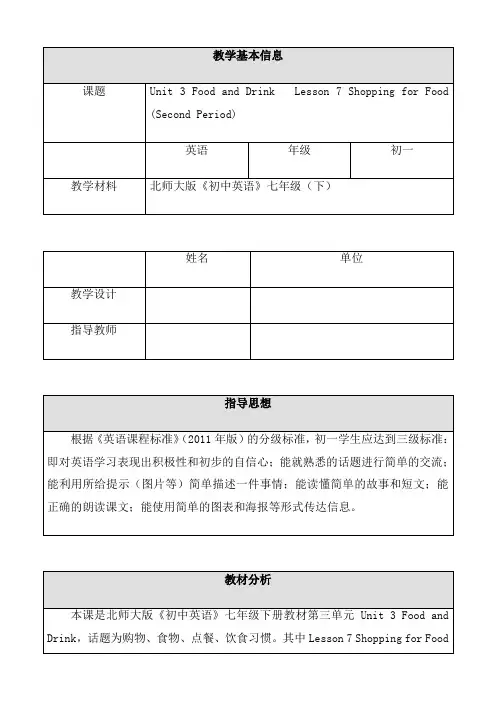
北师大版英语七下Unit 3 Lesson 7 Shopping for Food 第1课时教学设计一. 教材分析北师大版英语七下Unit 3 Lesson 7 Shopping for Food主要讲述了在超市购物时如何用英语进行交流。
本节课的主要内容包括:学习购物时可能用到的一些词汇如:apple, banana, milk, bread等;学习一些购物时的常用句型如:How much is it?Can I have a look? 等。
通过本节课的学习,学生能够掌握购物时的一些基本词汇和句型,提高他们在购物场合的英语交际能力。
二. 学情分析七年级的学生已经掌握了一些基本的英语语法和词汇,具备一定的英语听说读写能力。
但是,他们在真实的购物场合中运用英语进行交际的能力还比较弱。
此外,学生对于购物这一主题可能比较熟悉,但是涉及到购物时的英语表达可能还不够了解。
因此,在教学过程中,需要注重培养学生的英语交际能力,并联系他们的生活实际,让他们能够运用所学知识解决实际问题。
三. 教学目标1.知识目标:学生能够掌握购物时的一些基本词汇如apple, banana,milk, bread等;学生能够熟练运用购物时的常用句型如How much is it? Can I have a look? 等。
2.能力目标:学生能够在购物场合中运用英语进行简单的交际,提高他们的英语实际运用能力。
3.情感目标:培养学生对于英语学习的兴趣,让他们在学习过程中感受到英语的实用性,增强他们的自信心。
四. 教学重难点1.重点:学生能够掌握购物时的一些基本词汇和句型。
2.难点:学生能够在真实的购物场合中运用英语进行交际。
五. 教学方法1.任务型教学法:通过设计各种购物相关的任务,让学生在完成任务的过程中学习和运用英语。
2.情境教学法:创设各种购物情境,让学生在真实的语境中学习英语。
3.交际法:鼓励学生进行真实的英语交际,提高他们的英语实际运用能力。